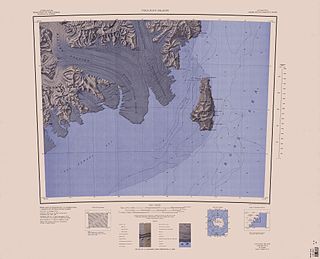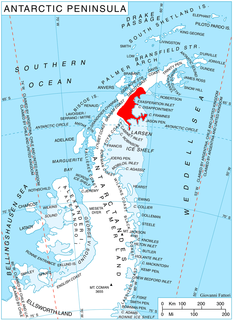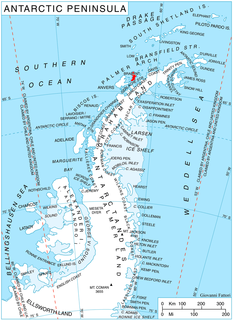
The Arctic Archipelago, also known as the Canadian Arctic Archipelago, is a group of islands north of the Canadian mainland.

Borchgrevink Glacier is a large glacier in the Victory Mountains, Victoria Land, draining south between Malta Plateau and Daniell Peninsula, and thence projecting into Glacier Strait, Ross Sea, as a floating glacier tongue, the Borchgrevink Glacier Tongue, just south of Cape Jones. It was named by the New Zealand Geological Survey Antarctic Expedition, 1957–58, for Carsten Borchgrevink, leader of the British Antarctic Expedition, 1898–1900. Borchgrevink visited the area in February 1900 and first observed the seaward portion of the glacier.

Leppard Glacier is a large valley glacier draining east between the Aristotle Mountains and Voden Heights, and flowing into Scar Inlet north of Ishmael Peak, on the east coast of Graham Land, Antarctica. The glacier was first seen from the air and photographed in part by Hubert Wilkins on December 20, 1928, and was surveyed by the Falkland Islands Dependencies Survey (FIDS) in 1955. It is now clear that, on the photographic evidence of his outward flight, Wilkins gave the name "Crane Channel" to this glacier, and that on his return flight he photographed what is now accepted as Crane Glacier, perhaps thinking that it was the same feature. Since Crane Glacier has been retained for the northern of these glaciers photographed by Wilkins, the UK Antarctic Place-Names Committee has named this feature for Norman A.G. Leppard, assistant surveyor with the FIDS, who surveyed this area in 1955.

Shearer Stack is a rock stack lying 1.5 miles (2.4 km) southwest of False Round Point, off the north coast of King George Island in the South Shetland Islands. Named by the United Kingdom Antarctic Place-Names Committee (UK-APC) in 1960 for the American sealing vessel Charles Shearer from Nantucket, which visited the South Shetland Islands in 1874-75. In 1877 the ship again sailed for the islands and disappeared without a trace.
Ullmann Point is a point marking the southwest end of Ullmann Spur in Martel Inlet, Admiralty Bay, on King George Island in the South Shetland Islands. The point was charted by the French Antarctic Expedition, 1908–10, under Charcot. It was named in association with Ullmann Spur some 20 years later.
O'Connors Rock is a rock 0.1 nautical miles (0.2 km) southwest of Stenhouse Bluff, King George Island, lying in Visca Anchorage in the north part of Admiralty Bay, in the South Shetland Islands. First charted by the French Antarctic Expedition, 1908–10, under Charcot. The name "O'Connor's Rock" was first used for this feature on a British chart and is probably after Midshipman W. P. O'Connor, Royal Navy Reserve, who assisted in a sketch survey of Visca Anchorage in the Discovery in 1927.
Denais Stack is a conspicuous rock stack lying 1.5 nautical miles (3 km) north of Point Thomas on the west side of Admiralty Bay, King George Island, in the South Shetland Islands. The name "Anse Denais," for one of the seamen on the Pourquoi-Pas?, was given by the French Antarctic Expedition, 1908–10, under Jean-Baptiste Charcot to a cove on the north side of Ezcurra Inlet. Recent air photos show no cove in this position and the name Denais has been transferred to the feature now described in order to preserve Charcot's naming in the area.

Visca Anchorage is the northwestern cove of Martel Inlet, Admiralty Bay, at King George Island in the South Shetland Islands. Charted by the French Antarctic Expedition, 1908–10, under Charcot, and named by him for Dr. Visca, an acquaintance in Montevideo.
Stump Rock is a rock lying close offshore in the west portion of King George Bay, 0.5 nautical miles (0.9 km) northwest of Martello Tower, in the South Shetland Islands. Charted and named during 1937 by DI personnel on the Discovery II.

Flagstaff Glacier is a very small glacier lying immediately north of Flagstaff Hill on Keller Peninsula, King George Island, in the South Shetland Islands. The name arose locally in about 1958 and derives from association with Flagstaff Hill.

Martel Inlet is an inlet forming the northeast head of Admiralty Bay, King George Island, in the South Shetland Islands off Antarctica. It was charted in December 1909 by the Fourth French Antarctic Expedition under Jean-Baptiste Charcot and named "Fiord Martel" after J.L. Martel, a French politician.
Mackellar Inlet is an inlet forming the northwestern head of Admiralty Bay, at King George Island in the South Shetland Islands. It was probably named by the Fourth French Antarctic Expedition under Jean-Baptiste Charcot, who charted Admiralty Bay in December 1909.
Sea Leopard Patch is a shoal with a least depth of 18 m, located near the center of Visca Anchorage, Admiralty Bay, in the South Shetland Islands. Charted in 1927 by DI personnel on the Discovery and named after the leopard seal Hydrurga leptonyx.
Ternyck Needle is a conspicuous nunatak, 365 metres (1,198 ft) high, standing 1.5 nautical miles (2.8 km) east of the head of Martel Inlet at the base of the small peninsula separating Admiralty and King George Bays, on King George Island in the South Shetland Islands. It was charted in December 1909 by the French Antarctic Expedition under J.B. Charcot, who presumably applied the name. It was first climbed in 1949 by Geoff Hattersley-Smith and Ken Pawson of the Falkland Islands Dependencies Survey.
Keller Peninsula is a high peninsula separating Mackellar Inlet and Martel Inlet in Admiralty Bay, on King George Island, in the South Shetland Islands of Antarctica. The name Keller was applied by the French Antarctic Expedition under Jean-Baptiste Charcot, who charted Admiralty Bay in December 1909.

Lange Glacier is a glacier flowing into the west side of Admiralty Bay close south of Admiralen Peak, King George Island, in the South Shetland Islands, Antarctica. It was charted by the French Antarctic Expedition, 1908–10, under Jean-Baptiste Charcot, and was named by the UK Antarctic Place-Names Committee in 1960 for Alexander Lange (1860–1922), a Norwegian pioneer of modern steam whaling in the South Shetland Islands in 1905–6, and commander of the Admiralen.
King George Bay is a bay indenting the south coast of King George Island for 6 nautical miles (11 km) between Lions Rump and Turret Point, in the South Shetland Islands. It was named on January 24, 1820 for the then reigning sovereign of the United Kingdom, King George, by a British expedition under Edward Bransfield.

Lister Glacier is a glacier 5 nautical miles (9 km) long and 1 nautical mile (2 km) wide, draining the northeast slopes of Stribog Mountains and flowing into Bouquet Bay just south of Duclaux Point on the northeast side of Brabant Island, in the Palmer Archipelago, Antarctica.

McLeod Hill is a rounded, ice-covered hill of elevation 1,790 m in the south part of Hemimont Plateau in Graham Land, Antarctica, which forms a prominent landmark 1 mi east of the head of Northeast Glacier. It was first roughly surveyed in 1936 by the British Graham Land Expedition (BGLE), and resurveyed by the U.S. Antarctic Service (USAS), 1939-41. It was resurveyed in 1946 by the Falklands Islands Dependencies Survey (FIDS) and named for Kenneth A. McLeod, Falklands Islands Dependencies Survey (FIDS) meteorological observer who, during July-December 1947, occupied with a member of the Ronne Antarctic Research Expedition (RARE) the plateau meteorological station 1 mi east of this hill.













